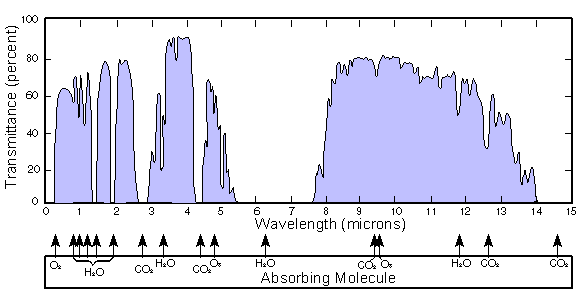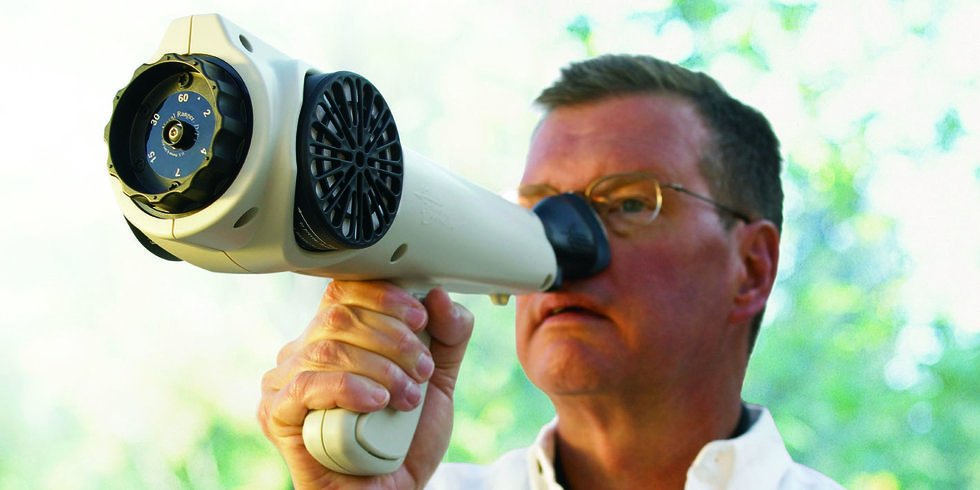• Can I work with generated imagery for this prompt or is that not what the assignment is about? The point of the Typology Machine assignment is to make a machine which automates capturing things, for the purposes of producing a typology. For this assignment, we require you to have a “collision with reality” at some point — i.e. you must capture real data, from the real world, with some sort of real sensor. If you would like to use the data you’ve captured in order to eventually train a generative system (like a GAN), that’s a separate question which is concerned more with how you present your typology. You should ask yourself whether GAN imagery is really the ideal output format for this project.
• You mentioned there was a specific band of high wavelengths that cannot be captured by IR cameras because the photons emitted from that light are absorbed by air. Hypothetically, if you brought an IR camera into a vacuumed space (like the literal cosmos, but really any airless chamber), would the camera see anything? If so, what would it be and how would the human eye understand it? Infrared light in the 5000-8000nm band (the “low transmittance window“, shown below) is absorbed by water in the air. Because of this, cameras which are specifically sensitive to that band of energy frequencies are not commonly manufactured. (The STUDIO’s thermal cameras are sensitive in the range of 8000-14000nm.) If someone were to build a camera that could sense energy in those bands, and if that camera was brought into a vacuum, then it would see whatever there was to be seen in that part of the spectrum. This set of wavelengths is on the border between emissive and reflective light. It is invisible to the human eye. The camera would store data in a buffer of pixels — an image indicating, for each pixel, how much energy was detected in that band of wavelengths. That image could then be rendered (using visible light) on your laptop, and viewed (using visible light) with your eyes, most likely as a grayscale image.

• What are the rules around doing a project in the Great Hall? This likely depends what you want to do. There are rules that govern the scheduling of the space, and then there would be other rules governing things like damage to the environs, or inappropriate behavior, etc. The CFA Dean’s office manages the schedule of the Great Hall, in case you need it to be empty, or if you wanted to avoid overlapping a public reception, etc.
• Is it a problem if two students capture the same thing? If we find that our ideas are very similar should we work to differentiate them or is that okay? We really doubt you’ll capture the exact same thing in the exact same way. Don’t worry about trying to differentiate yourselves, just do your work. If two students create projects with some similarities, then during the critique, it’s possible that we might discuss the contrasts in their approaches. This conversation will happen anyway.
• I want to do a project involving machine learning, but I have no experience. What is the best way to approach this? So, why is machine learning the right tool for what you want to investigate—what do you hope it will help you achieve? Do you just generally want to explore machine learning, or do you have a specific idea for how it would be useful for the Typology Machine project? We will provide some ML workshops and template projects later in the semester, but ExCap is not an ML course per se, and when we do teach applied ML for the arts in this course, we will focus on off-the-shelf toolkits and educational demos like those available with RunwayML, ml5.js, Google Teachable Machine, Wekinator, and the Gesture Recognition Toolkit. These tools are great for getting started with ML, and by all means, feel free to get started with these anytime you like; Dan Shiffman’s Coding Train has exceptionally good entry points.
• How do we know if an idea for a project is a good idea? By going to school and making lots of things, eventually you will develop a better intuition for this. It also helps to do multiple iterations, and discuss it with your professors and peers.
• I’m interested in what the act of categorization or collection reveals about the observer. I’m wondering what a typology of typologies (of the same subject) might look like, and whether that’s a viable conceptual path to take in this project. This sounds vague. Perhaps you could design a small collection of things that you ask different people to organize and sort, and then you could compare the ways that different people organize the same set of objects. For example, if you gave people a box of old crayons, some people might sort the crayons by their color, or by their length, or alphabetically by the name of the color.
• If we want to buy some form of equipment (from sensors to physical objects…) are there any forms of reimbursement for those? You mentioned having a budget; what might that cover? We offer no guarantees, but: email the professors; we may already have the thing you want, or we may know where you can borrow it from, or we may be willing/able to buy it for you. Making new purchases depends on many factors: whether it can be borrowed from somewhere; how much it costs; whether the thing you need is consumable or not; whether other students might conceivably be able to use it after you (for future projects); whether we still have funds remaining; and—with apologies—the quality and likely promise of your concept. (Life’s unfair: when a student has an amazing idea and has demonstrated that they have the skills to realize it, resources tend to materialize.) We’d like to help, but you should not expect your expenses to be wholly subsidized, and you should expect to have to spend some money on ‘art supplies’.
• Can the “data” acquired by the typology assignment be made in a single representative art piece, instead of a series of captures? This question doesn’t make sense to me (GL). The assignment clearly states that you must capture at least 3 things…. Or are you asking about how your work is presented (not captured)?
• I feel overwhelmed about technology. Besides office hours, are we going to have some time in class to get some technical support? Believe it or not, it’s great that you’re out of your comfort zone. If there’s a particular and specific piece of technology you’re struggling with, please contact us to make us aware of your issue. If you have a concept for something that you’d like to capture, and you don’t know how to realize your idea technologically, please contact us with your question and we may be able to offer some suggestions. We will continue to have technical workshops in class in which we demonstrate how to use various tools. We will also have work sessions and discussion roundtables in which you can approach us individually and directly (or consult with your peers) with your technical questions. Ultimately, however, you should be aware of the following:
- This is an advanced (not introductory) studio course. We expect you to already have some skills, or to have ‘learned how to learn’. Unfortunately, apart from providing template code for some activities, it’s outside the scope of this course to provide general, introductory instruction in programming, electronics, or signal processing. We recommend you take 15-104 (Introduction to Programming for Creative Practices) or 60-223 (Introduction to Physical Computing) or 18-090 (Twisted Signals: Multimedia Processing for the Arts) to learn more.
- If you have been admitted to this course — which you have — then it is because we feel very confident that you are qualified (in some way) to be here.
- This course is medium-agnostic, and (other our practical workshop exercises) you are never required to use any specific type of technology for any project. As we have repeatedly tried to make clear, we are using the term ‘machine’ in an expanded conceptual sense to mean a ‘process which can be automated’, that does not necessarily depend on the use of any software, computers or electronics. For example, in the Typologies lectures, we showed compelling low-tech projects like Kim Dingle’s United Shapes of America, Candice Breitz’ Madonna video, Rutherford Chang’s New York Times calendar; Andy Warhol’s Screen Tests; Eva Teppe’s orchestral visualization; Rachel Strickland’s Portable Portraits; or Stacy Greene’s Lipsticks. We would be thrilled if you made something as strong as one of these low-tech projects!
• I am really interested in production and pursuing internships as a production assistant. I was wondering if either one of you have any experience in this area and advice about pursuing this? GL: unfortunately this is not my area, perhaps NR is aware of something.
• What is the weirdest commercial sensor you’ve heard of? A “Food Texture Analyzer” is a device for measuring the hardness, gumminess, chewiness, cohesiveness, and elasticity of food. While it’s not very weird, in itself, I think one could do a lot of weird research with one. The weirdest sensor I know of is the “Nasal Ranger” field olfactometer, which measures the intensity of smells:

• Can we start experimenting with various capture technologies we might be interested in using for our project? Yes; email or speak with us.
• Is there a comprehensive list of the devices that the studio has available that we could peruse in order to do our own research into the scope of what is available? Yep, here it is again. This list is still in process of being updated. Note that it may be helpful to describe what you want to capture (cart and horse issue).